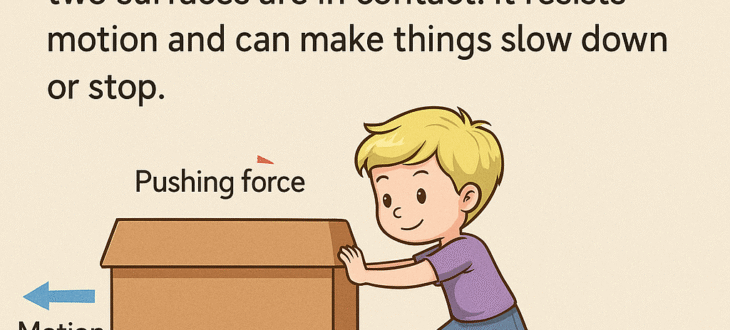Friction Class 8 Science Notes. The chapter explains static, sliding, and rolling friction, along with causes, advantages, and disadvantages. It also covers ways to increase or reduce friction for practical uses in daily life.
Friction is the force that happens when two surfaces touch and try to move against each other. It resists motion and can make things slow down or stop.
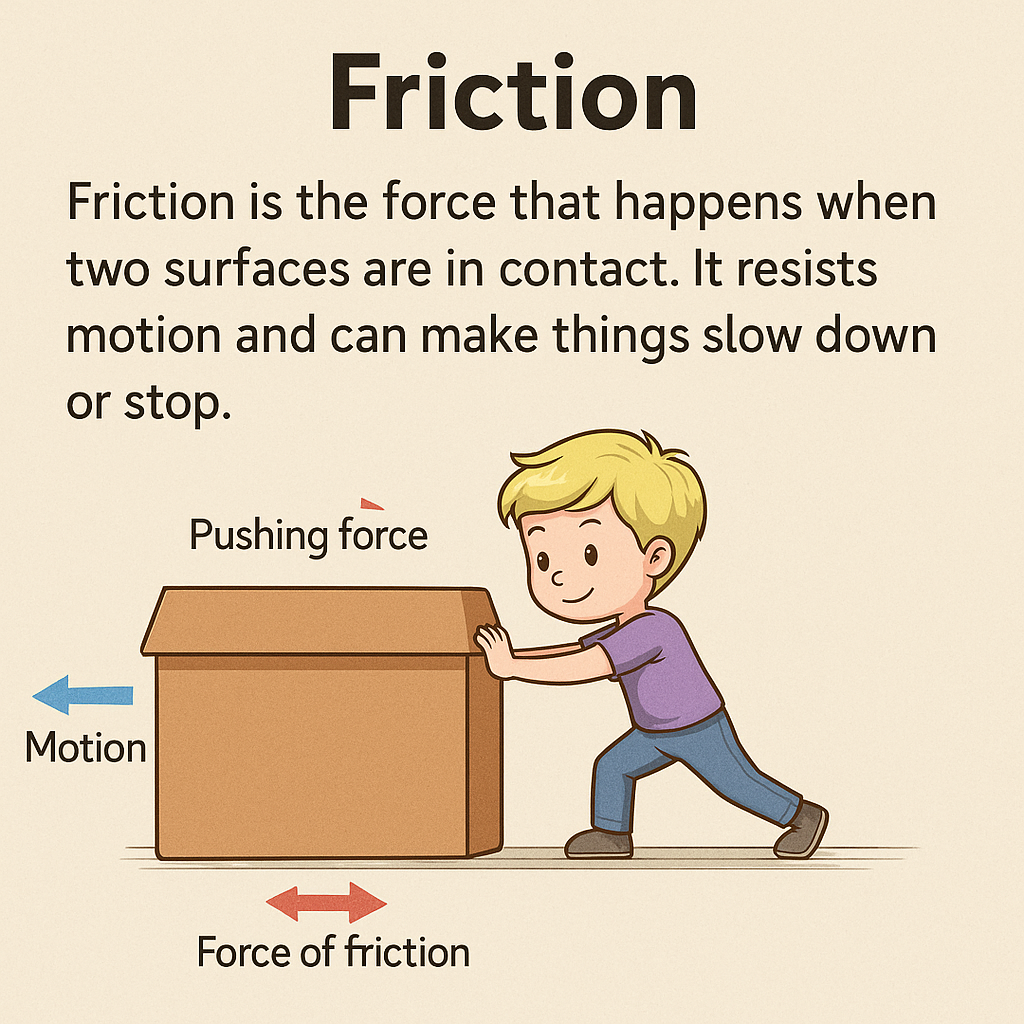
Relative motion – When one object moves relative to another it is called a relative motion.
Cause of friction: Friction is caused by the roughness or unevenness of the surfaces that are in contact. Even surfaces that look smooth have tiny bumps or irregularities. When these surfaces rub against each other, the bumps get stuck and resist motion, creating friction.
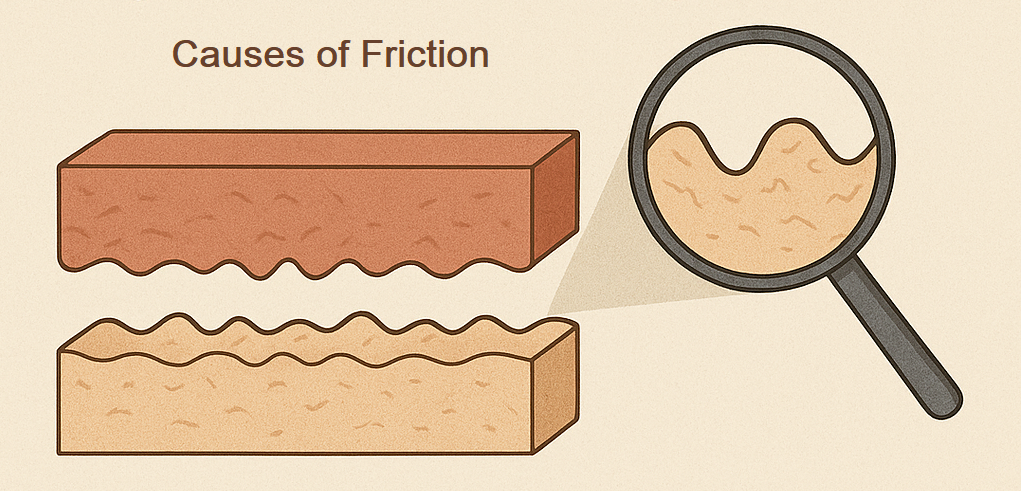
- Factors affecting friction: The friction between two surfaces depends on two factors:
- The nature of the two surfaces (roughnessof the two surfaces):
More the roughness of a surface, larger is the number of irregularities on its surface & hence greater will be the friction.
- The force with which two surfaces are pressed together:
Pressing together two surfaces of objects with a greater force will increase the interlocking in the two surfaces & hence increase the friction.
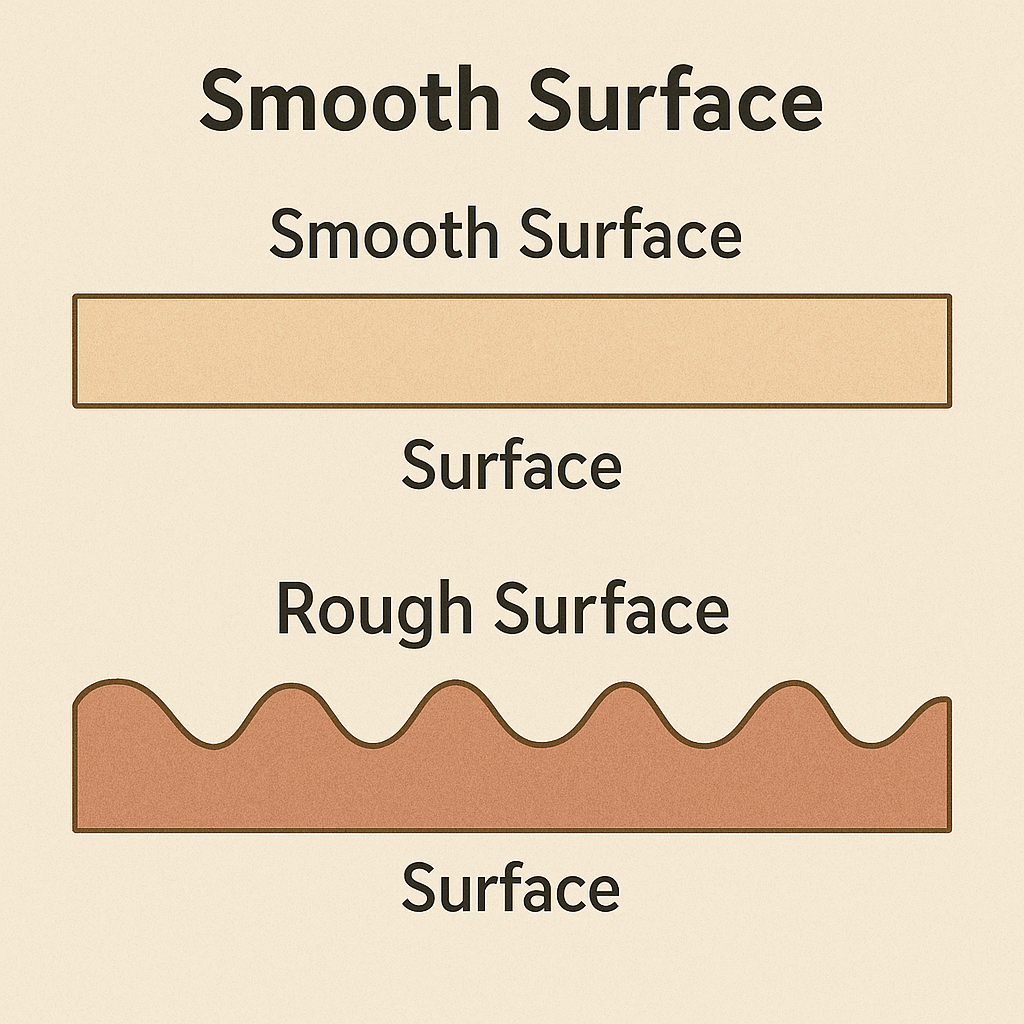
- Spring balance:
- A force can be measured using a spring balance.
- The unit of force is Newton (N)
- The pointer of the spring balance will be at zero, when nothing is hung from the hook of the spring balance.
- Calculating frictional force using a spring balance
- To determine the coefficient of friction between two surfaces, pull an object placed on a surface using a spring balance that is used to measure weight/ force in the unit Newton(N).
- Pull a spring balance connected to the object and slowly increase the force until the object begins to slide on the surface.
Make sure the spring balance is parallel to the surface. The reading on the spring balance scale when the load/ object begins to slide is a measure for the static friction, while the reading when the block continues to slide is a measure of sliding friction.
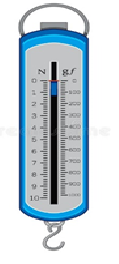
Friction is of three types:
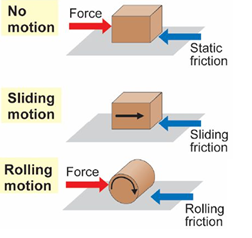
a) Static friction: is the friction that prevents an object from moving when it is at rest. It acts between two surfaces that are not moving relative to each other. This force must be overcome to start the motion of the object.
Example: When you try to push a heavy box but it doesn’t move, the force stopping it is static friction.
b) Sliding friction: is the force that acts against the motion when one surface slides over another. It is usually less than static friction, which is why it’s easier to keep an object moving than to start moving it.
Example: When you push a book across a table, the force that slows it down is sliding friction.
c) Rolling friction: is the force that resists the motion of an object when it rolls over a surface. It is usually less than both static and sliding friction, which is why things like wheels or balls roll more easily.
Example: A bicycle moves easily on the road because the wheels reduce friction through rolling.
NOTE:
Static friction > Sliding friction > Rolling friction
- Friction is a necessary evil because in some cases, friction is useful but in other cases friction is harmful.
- Advantages of friction:
Frictional force is necessary for various purposes in our daily lives such as:
Helps us walk – Friction between our feet and the ground stops us from slipping.
Helps vehicles move and stop – Friction between tires and the road allows cars and bikes to move and brake.
Allows us to write – Friction between the pen or pencil and paper helps us write.
Helps hold things – We can hold objects in our hands because of friction.
Produces heat – Friction can generate heat, which is useful in lighting a matchstick.
Stops objects from sliding – Furniture and other items stay in place because of friction.
Used in machines – Some machines use friction to work, like belts in a fan or conveyor belts.
Helpful in sports – Friction between shoes and the ground helps players run, jump, and stop quickly.
- Disadvantages of friction:
Wears out machines and tools – Friction causes parts of machines to rub and wear out over time.
Wastes energy – Friction changes useful energy into heat, which is often wasted.
Reduces speed – Friction slows down moving objects, like vehicles and machines.
Produces unwanted heat – Too much friction can make machines and engines hot.
Damages surfaces – Rubbing can cause scratches and damage to surfaces.
Needs more fuel – Vehicles use more fuel to overcome friction with the road and air.
Makes movement harder – It takes more effort to move heavy objects due to friction.
Limits efficiency – In machines, friction reduces overall performance.
- How can we reduce or increase Friction?
- Methods of increasing friction:
Sometimes we need to increase Friction so as to avoid slipping of objects, for example:
- The sole of the shoes is grooved so that the Friction between our feet and ground increases and we can walk safely
- The tyres are treaded so that they can have a better grip over the ground and allow the smooth movement of the vehicles.
- Brake pads are used in bikes to stop them suddenly from moving by increasing the amount of Friction.
- Kabaddi players rub their hands with soil which helps in increasing the Friction between the hands and allows them to have an easy grip of the opponent.
- Gymnasts also apply a coarse substance so that they can have a better grip due to increased Friction in their hands.
- Methods of reducing friction:
Sometimes in order to have a smooth movement of an object we need to reduce Friction. For example,
- The powder is sprinkled over the carrom board to decrease the Friction between the board’s surface and the striker. In this way, the surface of the carrom board becomes smooth.
- By making the surface smooth by polishing.
- By applying lubricants (like oil or grease).
- Applying oil or grease helps in avoiding interlocking between the two rubbing surfaces to a large extent. As a result, friction is reduced. Grease is used in bicycles and other motors or different parts of a machine to reduce Friction and increase their efficiency. Oil is applied on the hinges of the door so that they can move easily.
- By using wheels to move objects.
- By using ball bearings between the moving parts of machines.
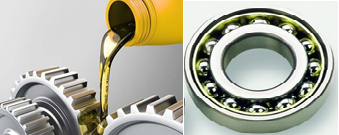
NOTE: (i) In some machines, it may not be advisable to use oil as lubricant. In such machines, an air cushion between the moving parts is used to reduce friction.
(ii) Friction can never be entirely eliminated.
- How wheels reduce Friction?
- We know that when an object rolls over a surface rolling Friction is produced which resists its motion on the surface. However, its magnitude is lesser than the static and sliding Friction.
- The wheels allow an object to roll over a surface rather than allowing them to slide over the surface. This results in less Friction and hence easy movement of the object.
- Rolling Friction is also used in the parts of machines that are moving continuously.
- In this way, the sliding Friction is removed with the help of rolling Friction and therefore the adverse effects of Friction such as the production of heat or wear and tear of the mechanical parts are also reduced.
- For instance, ball bearings are being used in fans and bicycles to reduce Friction.
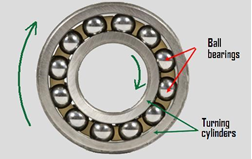
- Fluid friction:-
- Friction exerted by fluids i.e. gases or liquid is termed as fluid friction or drag.
- The magnitude of drag (fluid friction) depends on
- Speed of the object with respect to the fluid.
- Shape of the object
- Nature of the fluid.
- When object moves through the fluids, they have to overcome friction acting on them. In this process, they lose energy. Therefore, efforts are being made to minimize energy by giving special shape to the objects called ‘streamlined shape’. That’s why cars, airplanes & rockets have streamlined shape.
- For instance, ships and boats have a particular shape that allows them to resist fluid Friction.
- Birds and airplanes have a specific shape that allows them to fly in the air.
- Fishes also have a specific shape such as a tail and fins that allow them to swim continuously in water and even prevent the loss of energy due to fluid Friction.
- Not only this, all the vehicles are designed in a way that they can resist the fluid Friction because air is present everywhere.
